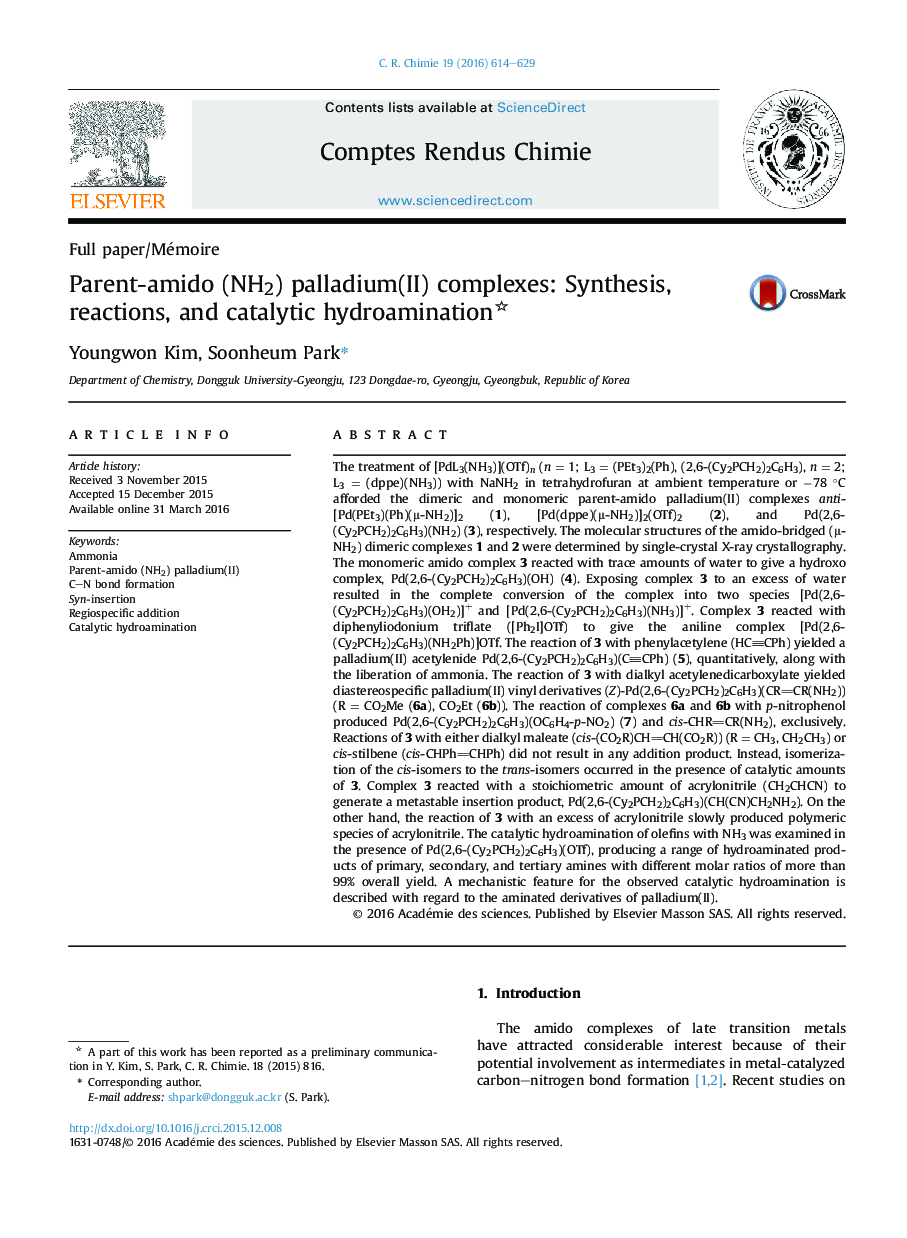| کد مقاله | کد نشریه | سال انتشار | مقاله انگلیسی | نسخه تمام متن |
|---|---|---|---|---|
| 10265138 | 458382 | 2016 | 16 صفحه PDF | دانلود رایگان |
عنوان انگلیسی مقاله ISI
Parent-amido (NH2) palladium(II) complexes: Synthesis, reactions, and catalytic hydroamination
دانلود مقاله + سفارش ترجمه
دانلود مقاله ISI انگلیسی
رایگان برای ایرانیان
موضوعات مرتبط
مهندسی و علوم پایه
مهندسی شیمی
مهندسی شیمی (عمومی)
پیش نمایش صفحه اول مقاله

چکیده انگلیسی
The treatment of [PdL3(NH3)](OTf)n (n = 1; L3 = (PEt3)2(Ph), (2,6-(Cy2PCH2)2C6H3), n = 2; L3 = (dppe)(NH3)) with NaNH2 in tetrahydrofuran at ambient temperature or â78 °C afforded the dimeric and monomeric parent-amido palladium(II) complexes anti-[Pd(PEt3)(Ph)(μ-NH2)]2 (1), [Pd(dppe)(μ-NH2)]2(OTf)2 (2), and Pd(2,6-(Cy2PCH2)2C6H3)(NH2) (3), respectively. The molecular structures of the amido-bridged (μ-NH2) dimeric complexes 1 and 2 were determined by single-crystal X-ray crystallography. The monomeric amido complex 3 reacted with trace amounts of water to give a hydroxo complex, Pd(2,6-(Cy2PCH2)2C6H3)(OH) (4). Exposing complex 3 to an excess of water resulted in the complete conversion of the complex into two species [Pd(2,6-(Cy2PCH2)2C6H3)(OH2)]+ and [Pd(2,6-(Cy2PCH2)2C6H3)(NH3)]+. Complex 3 reacted with diphenyliodonium triflate ([Ph2I]OTf) to give the aniline complex [Pd(2,6-(Cy2PCH2)2C6H3)(NH2Ph)]OTf. The reaction of 3 with phenylacetylene (HCCPh) yielded a palladium(II) acetylenide Pd(2,6-(Cy2PCH2)2C6H3)(CCPh) (5), quantitatively, along with the liberation of ammonia. The reaction of 3 with dialkyl acetylenedicarboxylate yielded diastereospecific palladium(II) vinyl derivatives (Z)-Pd(2,6-(Cy2PCH2)2C6H3)(CRCR(NH2)) (R = CO2Me (6a), CO2Et (6b)). The reaction of complexes 6a and 6b with p-nitrophenol produced Pd(2,6-(Cy2PCH2)2C6H3)(OC6H4-p-NO2) (7) and cis-CHRCR(NH2), exclusively. Reactions of 3 with either dialkyl maleate (cis-(CO2R)CHCH(CO2R)) (R = CH3, CH2CH3) or cis-stilbene (cis-CHPhCHPh) did not result in any addition product. Instead, isomerization of the cis-isomers to the trans-isomers occurred in the presence of catalytic amounts of 3. Complex 3 reacted with a stoichiometric amount of acrylonitrile (CH2CHCN) to generate a metastable insertion product, Pd(2,6-(Cy2PCH2)2C6H3)(CH(CN)CH2NH2). On the other hand, the reaction of 3 with an excess of acrylonitrile slowly produced polymeric species of acrylonitrile. The catalytic hydroamination of olefins with NH3 was examined in the presence of Pd(2,6-(Cy2PCH2)2C6H3)(OTf), producing a range of hydroaminated products of primary, secondary, and tertiary amines with different molar ratios of more than 99% overall yield. A mechanistic feature for the observed catalytic hydroamination is described with regard to the aminated derivatives of palladium(II).
ناشر
Database: Elsevier - ScienceDirect (ساینس دایرکت)
Journal: Comptes Rendus Chimie - Volume 19, Issue 5, May 2016, Pages 614-629
Journal: Comptes Rendus Chimie - Volume 19, Issue 5, May 2016, Pages 614-629
نویسندگان
Youngwon Kim, Soonheum Park,